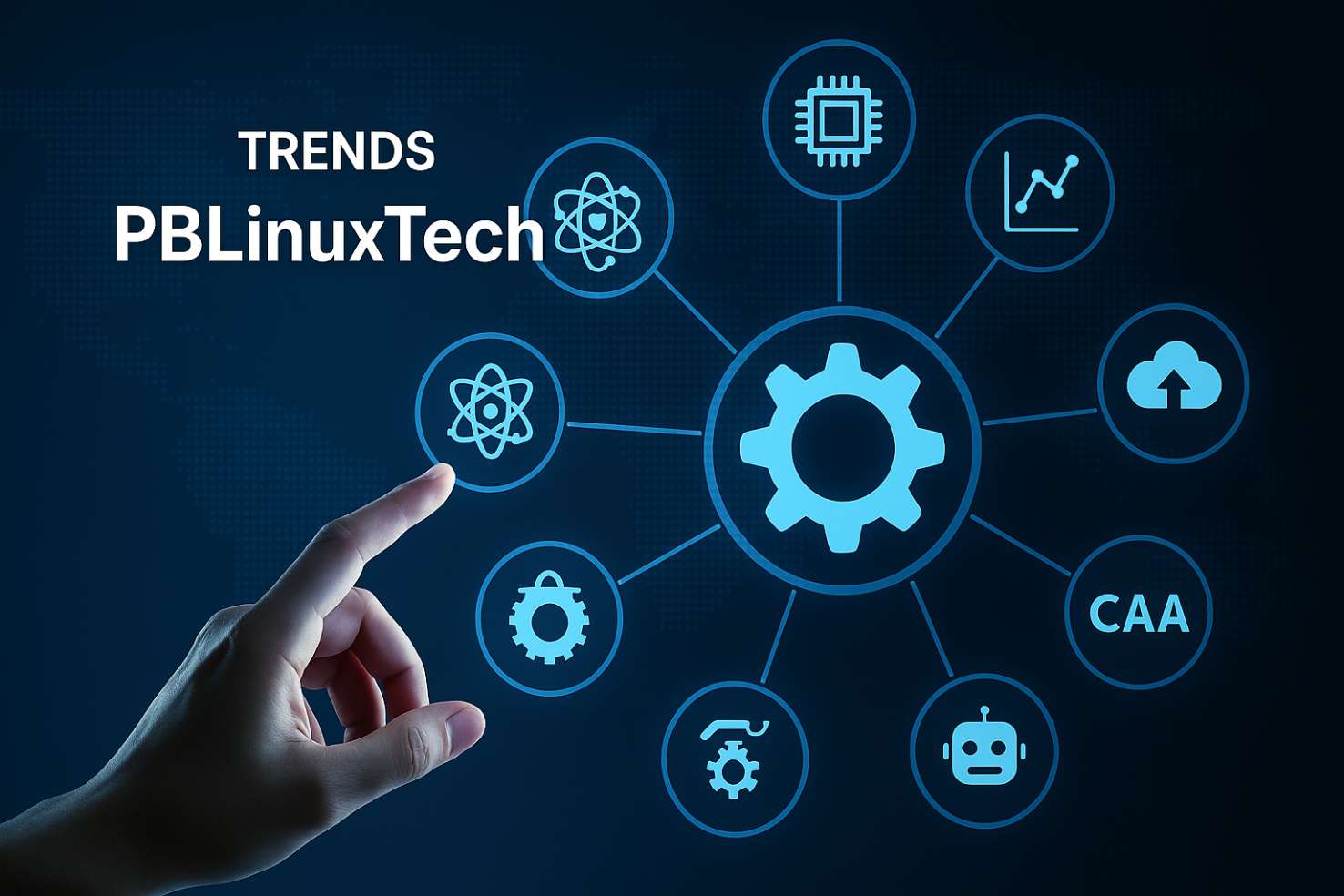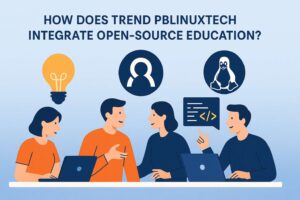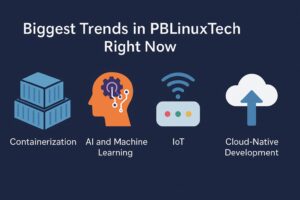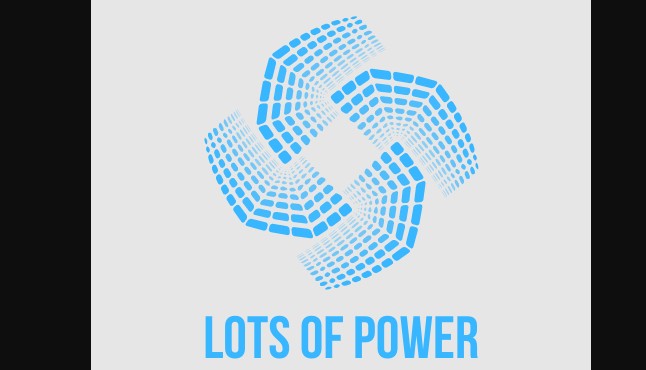
If you’ve been curious about how Linux technology is evolving and why so many tech communities are talking about it, you’ve probably stumbled upon the term trend pblinuxtech. Over the past few years, it has become a hub for innovation, education, and open collaboration in the Linux ecosystem. In 2025, it’s not just about operating systems anymore—it’s about shaping the future of tech for beginners, professionals, and entire industries.
This guide walks you through what it is, the trends shaping it, and why it matters more than ever. We’ll look at how it’s influencing software development, cybersecurity, cloud computing, and even sustainability.
What Is Trend PBLinuxTech and Why Is It Important in 2025?
Trend PBLinuxTech is a movement within the Linux and open-source community that merges Problem-Based Learning (PBL) with Linux-based technology. Instead of learning through theory alone, users solve real-world technical challenges—everything from setting up secure servers to deploying scalable cloud applications.
In 2025, this approach is important because technology is changing too quickly for purely academic learning to keep up. PBLinuxTech equips learners with the practical skills they need while encouraging collaboration and community-driven innovation.
How Is Trend PBLinuxTech Changing the Linux Landscape?
Linux has long been popular with developers, but it was often seen as intimidating for new users. By using problem-based learning, trend pblinuxtech breaks down barriers. The result is:
- Better accessibility: Clearer documentation, video tutorials, and interactive learning environments.
- Broader adoption: Schools, universities, and bootcamps are introducing PBLinuxTech projects into their curriculum.
- Industry relevance: Businesses are using this method to upskill IT teams and speed up innovation.
Before vs. After PBLinuxTech Impact:
| Aspect | Before | With PBLinuxTech |
| Learning Style | Text-heavy manuals | Hands-on, task-based |
| Accessibility | Complex for beginners | Beginner-friendly |
| Industry Use | Niche IT teams | Mainstream across sectors |
| Community Collaboration | Limited forums | Active, problem-solving groups |
What Are the Core Goals of Trend PBLinuxTech?
- Promote Open-Source Education Worldwide – Making Linux learning materials free and accessible.
- Integrate Real-World Problem Solving – Encouraging learners to work on scenarios they’d encounter in the workplace.
- Foster Global Collaboration – Connecting learners and professionals across countries through shared projects.
These goals aren’t just theoretical—they’re already in action in open-source projects, collaborative coding events, and online courses that use a PBL approach.
How Does Trend PBLinuxTech Integrate Open-Source Education?

Traditional tech training often teaches commands and concepts in isolation. Trend PBLinuxTech flips this around. Learners start with a real-world challenge—for example:
- Deploying a secure cloud app.
- Automating data backups.
- Optimizing server performance for high-traffic sites.
Through solving these problems, they naturally learn Linux commands, file systems, security protocols, and networking concepts. This makes the lessons memorable and directly applicable.
What Are the Biggest Trends in PBLinuxTech Right Now?

How Is Containerization and Microservices Shaping PBLinuxTech?
Containerization—using tools like Docker and Kubernetes—is transforming Linux deployments. Microservices architecture allows developers to split large applications into smaller, independent parts, making them easier to develop and maintain. This trend fits perfectly with PBLinuxTech’s focus on building modular, adaptable solutions.
What Security Measures Are Becoming Standard in PBLinuxTech?
Security is now part of the development process from day one. Multi-factor authentication, zero-trust networking, and advanced encryption are built into the learning experience. Learners not only build apps—they also secure them against real-world threats.
How Is Automation and Infrastructure as Code (IaC) Used?
Tools like Ansible and Terraform let users manage infrastructure through code, making setups repeatable and error-free. In PBLinuxTech projects, this means teams can replicate complex environments in minutes, perfect for testing and deployment.
What Does Cloud-Native Development Mean for PBLinuxTech?
Cloud-native apps are designed for distributed, scalable environments like AWS, Azure, and Google Cloud. PBLinuxTech incorporates these concepts so learners can create applications that run efficiently anywhere.
Why Is Edge Computing and IoT Important to PBLinuxTech?
IoT devices—from smart thermostats to industrial sensors—are growing fast. Edge computing allows data to be processed locally, improving speed and reducing latency. PBLinuxTech projects often include building or securing these systems.
How Is AI and Machine Learning Being Integrated?
AI is entering Linux workflows with predictive analytics, automated system monitoring, and even AI-assisted coding. PBLinuxTech learners are encouraged to integrate these tools into their solutions.
How Does DevSecOps Fit Into the Future of PBLinuxTech?
By embedding security practices throughout the development cycle, DevSecOps ensures that speed doesn’t come at the cost of safety. This is a perfect match for the problem-based learning model.
How Is PBLinuxTech Supporting Sustainability and Green Computing?
Energy-efficient coding, low-power hardware setups, and optimized server configurations are increasingly part of the curriculum. Learners see how tech can reduce environmental impact.
How Is Linux Becoming More Accessible and Exciting for Beginners?
Linux used to be considered “by developers, for developers,” but now there are beginner-friendly distributions like Ubuntu, Linux Mint, and Pop!_OS. PBLinuxTech projects provide step-by-step paths that teach the core skills without overwhelming new users.
The emphasis is on practical wins early on—such as setting up a media server or automating personal backups—so beginners feel a sense of accomplishment.
How Does Trend PBLinuxTech Help People Learn Linux Step-by-Step?
The learning structure is designed to move from simple to advanced:
- Setting up a Linux environment.
- Learning command-line basics.
- Managing files and processes.
- Networking and security fundamentals.
- Deploying real-world projects.
This gradual build-up ensures that by the time learners reach advanced topics, they’ve already mastered the essentials.
How Is PBLinuxTech Influencing Tech in the USA and Globally?
In the USA, universities and coding bootcamps are integrating PBLinuxTech projects into their syllabi. Globally, nonprofits are using this approach to teach Linux skills in regions where access to formal IT education is limited.
Corporations also benefit—companies use PBLinuxTech-inspired training to upskill employees for cloud migrations, cybersecurity roles, and DevOps positions.
What Are the Challenges Facing PBLinuxTech in 2025?
While the benefits are huge, challenges remain:
- Hardware compatibility: Some devices still lack solid Linux driver support.
- Security risks: Open-source is powerful, but vulnerabilities must be patched quickly.
- Resistance to change: Some organizations still rely heavily on proprietary software.
What Does the Future of PBLinuxTech Look Like Beyond 2025?
Expect stronger integration with AI, more focus on eco-friendly computing, and even gamified learning environments where users complete missions to unlock advanced skills. As Linux continues to lead in cloud, IoT, and security, PBLinuxTech will likely be a cornerstone of modern tech education.
How Can You Get Involved with PBLinuxTech?
- Join open-source communities on platforms like GitHub and GitLab.
- Attend hackathons focused on Linux solutions.
- Contribute to documentation or create beginner tutorials.
- Enroll in PBL-based Linux courses online.
You don’t need to be an expert to start—just willing to learn and contribute.
FAQs
Q1: What does PBLinuxTech stand for?
It stands for Problem-Based Learning combined with Linux technology—a method that focuses on solving real challenges instead of only learning theory.
Q2: Is PBLinuxTech only for advanced Linux users?
No. While experienced users can benefit, the approach is designed to guide beginners from zero knowledge to professional-level skills.
Q3: How is PBLinuxTech different from other Linux initiatives?
Its focus on real-world problem solving and project-based learning makes it more practical and interactive.
Q4: Can beginners benefit from PBLinuxTech resources?
Yes. Many tutorials start with basic tasks, gradually introducing advanced concepts without overwhelming learners.
Q5: What industries can gain the most from PBLinuxTech trends?
Cloud computing, cybersecurity, IoT, data science, and AI development all benefit from PBLinuxTech-trained talent.





